- Home
- Tim Winton
The Boy Behind the Curtain Page 11
The Boy Behind the Curtain Read online
Page 11
The heat here is dry. Perspiration evaporates in the desert wind before you have a chance to notice it. Within a minute or two my eyeballs are so parched the lids begin to stick and grate. The mask and fins feel like jelly in my hands.
The sea’s only 100 metres away but by the time we reach the shore we’re half knackered, and it’s not much relief anyway – in the shallows the water temperature hovers around 30 degrees. Still, if you dunk yourself and stand in the gale you feel coolish for a moment or two.
Neither of us has the energy for a big swim. We content ourselves with a visit to the rocky bar at the mouth of the dry creek. As we kick toward that little reef, the top layer of the water is so warm it’s hazy, and to keep our masks from fogging up we haul ourselves along the rubble-strewn bottom whenever we can; it’s cooler there. Besides, the tide is turning and the current is tough, and crabbing along the seabed is easier than kicking up in the heat.
Ahead of us bluebone and garfish peel away and head for shelter. A big turtle clocks us and veers off. Near the rock bar, a hunk of coral-encrusted stone no bigger than a badly bogged LandCruiser, we pause awhile to get our breath. At low tide, when it stands proud of the pebbly shore, this is an unprepossessing bit of littoral. It’s neither completely of the ocean nor of the land. In one of its crevices there are giant clams whose jaws are filled with petrified desert soil and stones. But on a high tide during a full moon, the sea overwhelms this chunk of range country and for an hour or so makes the place its own.
The trick is to get close to the bar and then swim hard enough at the last moment to grab hold. You’re only in a metre of water but it’s difficult to maintain position and you can barely keep your feet against the torrent. At the surface it’s just a boil of retreating water over a dull bit of rock, but underneath it’s all colour and action. You hang on, let your legs wallow behind you in the current, and the first thing you see is dozens of blue-spotted lagoon rays with their heads tucked under the ledge, their tails wafting beneath you. Once you get your bearings you clamber sideways until you’re wedged beside one of the clefts through which the traffic pours on the current.
And the traffic is hectic, ceaseless. In columns three and five deep baby emperors and bream and coral trout fly past, parting and merging to avoid colliding with you in flashes of silver, gold, blue, bronze, white, in stripes and spots and chevrons and blazes. Hundreds of them, streaming past silently in their mad splashes of colour. It’s like an acid trip from which you can exit at any moment by simply lifting your head. Ashore there’s a wary osprey astride a bleached stump and beneath him the charred remains of a bonfire from last winter. Drop your face back in and it’s something out of Kubrick, all hurtling colours and shapes and patterns so intense as to be slightly mind-bending. It’s like standing in the middle of the freeway, addled and awed and happy as a loon.
I count them off – fingermark, Spanish flag, trevally, honeycomb cod – and soon lose track. My arms ache but we stay as long as the current lasts and the water with it, and in the end we have to wade home the way we swam. By the time we’re up the sandy track and back on the doorstep we’re dry again and the hair stands up on our heads in spiky shocks as if to signal the level of our childish excitement. It might be there again tomorrow. But the day after the spectacle will be gone. For another month the rock bar will be high and dry. We’ll walk past it and I’ll stop as I do nearly every day and look at the desert packed into the mouth of the clam that sprouts from its brow like an improper thought.
The Wait and the Flow
On the beach one day, as I was sliding my board back onto the tray of the ute and trying to clear my sinuses of salty water, an old neighbour who was passing by with his dog told me he didn’t know what people like me saw in surfing. He said, ‘I see youse blokes out there day and night. Any time I go past you’re just sittin there, bobbin around like moorin buoys. Tell me, Timmy, what’s the point?’ And I didn’t know how to answer. Almost every day of my life is shaped according to the weather, most acutely to swell, tide and wind direction. After surfing for fifty years, you’d think I’d be able to give a better account of myself. But there wasn’t much to tell him, because there is no point. Surfing is a completely pointless exercise. Perhaps that’s why I’m addicted to it. But he was right, my neighbour, God rest him. We go to the water every day and every hour we can. And most of what we do is wait.
I grew up near Scarborough Beach in the sixties where surfing was the local culture. At the age of five, when my teenaged cousins, both girls, pushed me out on a big old longboard, I was more scared than excited. The physical details and sensations are still vivid and fresh in my mind. Like the greeny tint in the board’s resin and the weave of the Volan cloth beneath it. The deck was bumpy with paraffin wax. I remember the stolid symmetry of the three wooden stringers under all that fibreglass. Everything about the trek out to the break was overwhelming: the light and noise, the sheer heft of the board, the nervous anticipation. I wasn’t paddling, I was being ferried out there in my Speedos. Then, without warning, I was spun around. The air roared all about me. Suddenly I was rushing shoreward, flat out. And that was it. I was gone from that moment on. I wanted more. I wanted to be a surfer.
I began riding Coolites, the way you did as a beginner in those days. They were stubby styrofoam demons without fins and I skated about on one for a year until someone showed me how to cut a hole in the hull and wax in a bit of plywood for a skeg. The rashes we got from those foam boards were horrendous; it’s a wonder I’ve still got nipples. The best thing you could say about the Coolite is that you could surf it between the flags and keep your mum and those pesky lifesavers happy all at once. They were pigs to ride but you couldn’t kill anybody with one when you fell off and it went bouncing and fluttering beachward through the wading throng. I did a lot of falling off; it was my specialty.
These were the primary school years. I surfed for hours at a time, until my face and back were roasted and my little chest was a grated, weeping mess. I’d spend the final hour studiously avoiding eye contact with my poor mum who’d be madly waving me in from the shore.
My first glass board was a 7-foot egg with a radical raked fin. This was 1973. By then the shortboard era had well and truly arrived and this thing was already a relic. It rode like a longboard, and though along with everyone else I soon progressed to shorter and shorter craft, I never forgot the pure, gliding feel of those old-school boards and the graceful way good surfers rode them. These were the guys I watched most, the blokes who’d quickly become uncool in the seventies.
The most obvious attraction of surfing is the sheer momentum, the experience of rushing toward the beach. It’s a buzz. And though you might repeat the experience millions of times in thirty or forty or fifty years, the prime thrill never fades. It looks repetitive but no ride is ever the same; it feels like a miracle every time you do it and I’d hate to lose that sense of wonder.
Surfing has its origins in Polynesian ritual and play. At one level it was a display of power and caste: kings and princes standing proud and insouciant on their olos, commoners bellying in on alaias. But it was also about grace and beauty. Early illustrations and accounts depict scenes of boisterous celebration and physical prowess. Surfing was fun; it was liberating. It was this spirit of freedom and grace that haoles witnessed in Hawaii, from Cook onwards. They marvelled at it and they wanted to emulate it. Jack London was hardly the first, but he’s a notable convert. You might say that in this instance the missionary impulse was reciprocal. With their aloha spirit, the Hawaiians let the rest of the world in on one of life’s great pleasures and it’s hard to overestimate the cultural impact of surfing since it spread from the Islands. Here in Australia it helped shape people’s sense of themselves; since the forties it’s gradually become an identifiable element of our national culture, an expression of youthful vigour, engagement with nature, lust for life. In the fifties surfing became a form of individual expression, too, an act of rebellion. When most Austra
lians seemed anxious about sticking out in a crowd, surfers wanted to distinguish themselves. They weren’t exactly gracious in going their own way, they were brash and selfish, ensnared by a beatnik resistance to conformity that’s easy to ridicule now, but it’s worth bearing in mind just how rigid the social mores were at the time. Surfing and beach life offered an alternative to local orthodoxy – which was to submit to the group, join the club, buy the stuff. In an era of shiny surfaces, new appliances and suburban indoor order, surfers were heretics. And they liked it that way; they celebrated the rebel. While their mums and dads still venerated dominion over nature and separation from it, surfers were, consciously or not, in the vanguard of those who sought to honour the natural world; surfing is done at the mercy of the elements and requires an intimacy with them beyond the ken of a golfer or a tennis player. To surf, a person foregoes timetables and submits to the vagaries of nature.
The late sixties and early seventies were surfing’s Romantic era. I came to it at the peak of this period and it had a lasting impact on me. Back then we thought we were special when we were just lucky. We surfed with a sense of kinship with each other and with the sea that marked us out, if only for a while. We spoke a lingo that puzzled our parents and not all of it was hippie nonsense. What we craved was flow. The activity influenced our conceptual framework in ways that aren’t always credited. Non-surfers, it seemed to me, strove for symmetry, linear order, solid boundaries. Waiting and flowing were anachronistic notions, they’d nearly become foreign concepts, but to me they were part of an imaginative lexicon, feeding something in me that had to do with more than surfing. The child of a pragmatic, philistine and insular culture, I responded to the prospect of something wilder, broader, softer, more fluid and emotional. It sounds unlikely but I suspect surfing unlocked the artist in me.
Of course this was all before surfing became yet another occupied territory. By the eighties it had been colonized and pacified by the corporate world, and its language and attitude reflected its captivity. How eager surfers were to surrender their freedom! Suddenly they needed to be respected. Board riders wanted to be sports stars and millionaires. So began the years of dreary contests and sponsor-chasing, the chest-beating and swagger, the brawls in the surf. Surfers distinguished themselves by their machismo and their ultranationalism. The dominant mode was urban, aggressive, localized, greedy, racist and misogynistic. Out with all that touchy-feely shit. Surfers became jocks, defiant morons who trashed beaches and scowled at each other on the break. I wonder how many five-year-old boys were introduced to surfing in the eighties by girls. By then women were almost entirely absent from the surf. Driven out by the bellicose mood, they were consigned to the beach. Gidget made way for Puberty Blues. What I knew as something soulful was now the preserve of violent thugs like the Bra Boys. I gave up and walked away for shame. I put on a mask and snorkel. It was quiet and solitary underwater. You weren’t at the mercy of the big swinging dicks.
But I missed surfing badly. After a couple of years abroad I moved to a coastal hamlet where there were waves and a few surfers with an attitude mellow enough to suit me. It was a treat to paddle out again, to wait, to glide, to flow. There were others like me, who came back to surfing in the nineties when pure fun was valued again. They were past all the aggro, they’d outgrown their self-consciousness, and they were sick of the belligerent conformity that had overtaken the ‘sport’. They rebelled anew and rode strange craft unseen for decades, glorying in eccentric board shapes and retro designs. Sitting on the break you’d see people smiling, speaking to each other once again. The slit-eyed surf punks were still out there, slashing and snarling and scowling, but they were no longer the only tribe afloat. And the women were back, thank God. Within a decade girls were a constant, active and growing presence in the water.
To me surfing has always been a matter of beauty and connectedness. Riding a wave to shore can be a meditative activity; you’re walking on water, tapping the sea’s energy, meeting the ocean, not ripping anything out of it. Few other water pursuits are as non-exploitative. Humans exist by creative destruction; there’s no evading that reality. So having some major interactive pleasure in the natural world that comes without mortal cost – that’s precious, something to celebrate. The physical sensation of sliding along a wall of water, vividly awake and alive, is difficult to describe to the non-surfer; it feels even more beautiful than it looks. And for some men – men in particular, whose lives are so often circumscribed by an exclusively utilitarian mindset – surfing is the one pointlessly beautiful activity they engage in. There is no material result from two hours spent surfing. All the benefits are intangible, except perhaps the calibration of mood. Everyone close to me knows that when I come home wet, I’m a happier man than when I left. Think of the Prozac I’ve saved.
I credit surfing with getting me through adolescence. When I was lonely, confused and angry, the ocean was always there, a vast salty poultice sucking the poison from my system. If surfing’s addictive, and I’m bound to concede that it is, all I can say is there are so many more destructive addictions to succumb to. Even in my middle age it continues to provide respite. When I get in the water I slow down and reflect. That’s the benefit of all that bobbing and waiting. I wait and wait and then I glide and flow. I process problems without even consciously addressing them. The wider culture expects you to hurl yourself at the future. Surfing offers a chance to inhabit the present.
The wait and the glide have become a way of life. Strange as it might seem, the life of a novelist is often like that of a surfer. I come to the desk every day and mostly I wait. I sit for hours, bobbing in a sea of memories, impressions and historical events. The surfer waits for swells, and what are they but the radiating energy of events across the horizon, the leftovers of tempests and turmoils already in the past? The surfer waits for something to turn up from the unseen distance and if he’s vigilant and patient it’ll come to him. He has to be there to meet it. And when it comes he has to be alert and fit and committed enough to turn and ride that precious energy to the beach. When you manage to do this you live for a short while in the eternal present tense. And the feeling is divine.
That’s how I experience writing, which is its own compulsion. I show up. I wait. When some surge of energy finally arrives, I do what I must to match its speed. While I can, I ride its force. For a brief period I’m caught up in something special, where time has no purchase, and my bones don’t ache and my worries fall away. Then it’s all flow. And I’m dancing.
In the Shadow of the Hospital
In 1995 veteran folksinger Loudon Wainwright III released a typically mordant song in which he catalogues the births, breakdowns, deaths and near misses of friends and family. Somehow, in ‘That Hospital’ all the health campuses of memory coalesce as a single monolithic entity, a site of inescapable mortality. That hospital, Wainwright senses, will never be done with him; it will always be there, waiting.
Hospital. The word itself carries historical notions of shelter, respite and hospitality. The modern institution remains a refuge, a place of deliverance. It’s often a bulwark against chaos. Anyone who’s ever needed a hospital in a hurry knows the otherworldly sanctuary it promises. One afternoon in the Greek islands thirty years ago I sat in a small boat holding my infant son’s scalp together with my thumbs as we beat into a gale toward the prospect of harbour and hospital. Although the clinic we were trying so desperately to reach was a seedy little affair my wife and I had little faith in, during that rocky passage it became in my mind a citadel of hygiene and expertise. In extremis, we yearn for the hospital, and yet the rest of the time, if you’re anything like me, the very word brims with dread. Like the aging Canadian strummer, I have a lifelong preoccupation with that hospital, an aversion I’m too proud to call a phobia.
In my earliest apprehensions of hospital it was a mysterious reservoir of bounty. This was where mums and dads got their babies. And though I’d apparently come from there myself, I’d n
ever been back to see. Grown-ups spoke of it as a place where broken arms were fixed, where sick people went to get better; it was amazing what they could do these days. On visits to the city when a parent pointed out some bland tower and said it was a hospital I struggled to match this with the miracle factory I’d imagined. But by the time I was five I knew better. Hospital was trouble. You didn’t want to go there because if you got out at all you came home in ruins.
I was still a small boy when my father suddenly disappeared. It took a long time for me to understand that there had been an accident. My mother tried to reassure me. So did the policemen who came to the door every day. They all said my dad would be okay – he was doing fine, the folks in the hospital were looking after him, it was incredible what they could do these days, and he’d be back in no time. We just had to sit tight. But he wasn’t back even in a long time, and all those other words of comfort began to sound like lies. Our little brick-veneer bungalow in the outer suburbs had never felt so empty and isolated. As the weeks went by I began to suspect hospital was a place from which people could not return. If Dad was doing so well there, why was Mum crying all the time? And if this was the best place for him right now, why couldn’t I visit? He was sleeping, they said. But I knew that was what they told kids when people were dead and they were too scared to say. Even after someone came by with the startling news that Dad was finally awake, there would be no visits. The weeks rolled on.
Then one day a big white armchair appeared in the lounge. It seemed to take up half the room. Mum said we were having a special visitor. And that afternoon a pale and wizened creature was carried into our house and carefully lowered into that new chair as if made of glass. His eyes were the colour of broken red bricks and he breathed through a hole in his neck. If I squinted a little he looked a bit like my dad, but he was so much older and too feeble-looking. My father was a big, strong, vigorous man. And yet everyone in the room – the off-duty coppers, the blokes from the hospital and even my mother – kept saying his name over and over: Johnny, John, John! They shook their heads in wonder and joshed with him, laughing as if this were a great day indeed. Though I didn’t really recognize him I took everyone’s cue and played along. If anything I was a little afraid of this husk in our midst. If this was my dad, something awful had happened to him. He’d been carted off to Royal Perth and sent home as a wreck.

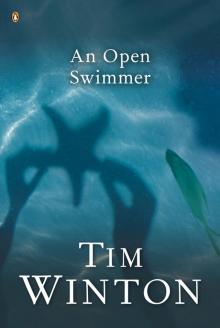 An Open Swimmer
An Open Swimmer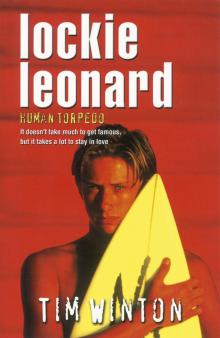 Human Torpedo
Human Torpedo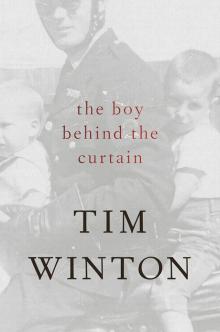 The Boy Behind the Curtain
The Boy Behind the Curtain Scission
Scission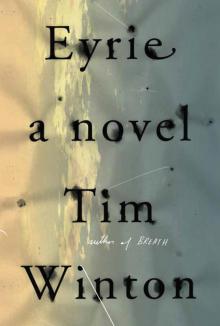 Eyrie
Eyrie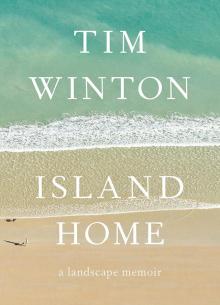 Island Home
Island Home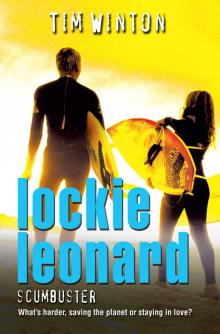 Scumbuster
Scumbuster The Turning
The Turning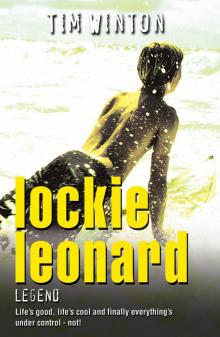 Legend
Legend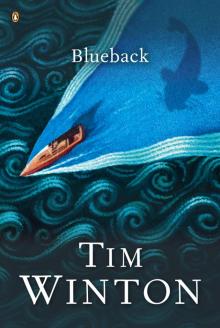 Blueback
Blueback Signs of Life
Signs of Life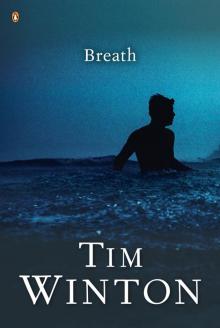 Breath
Breath Land's Edge
Land's Edge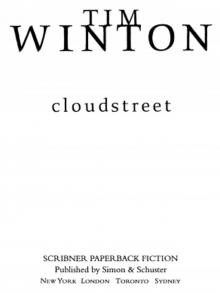 Cloudstreet
Cloudstreet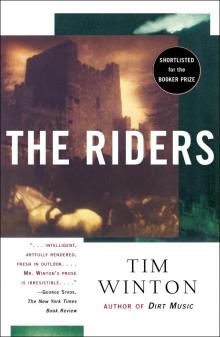 The Riders
The Riders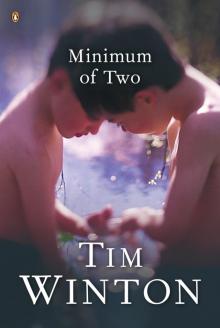 Minimum of Two
Minimum of Two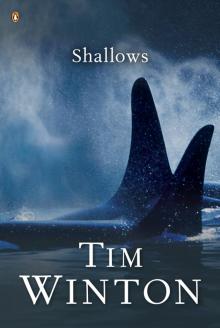 Shallows
Shallows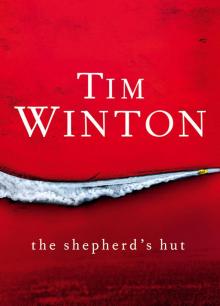 The Shepherd's Hut
The Shepherd's Hut In the Winter Dark
In the Winter Dark